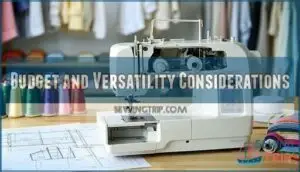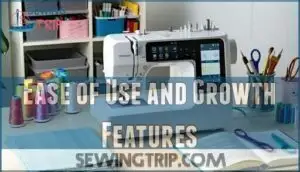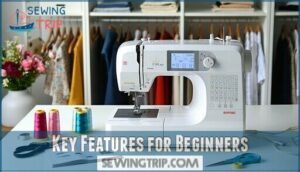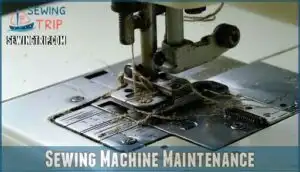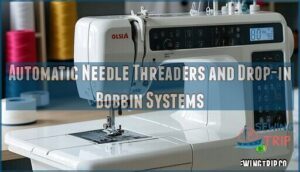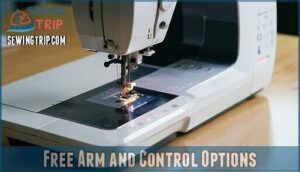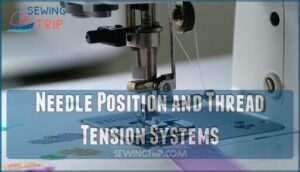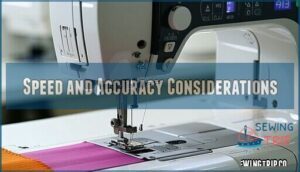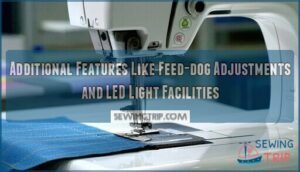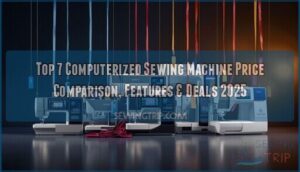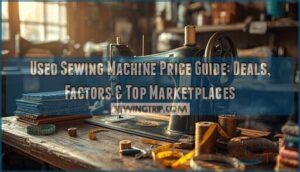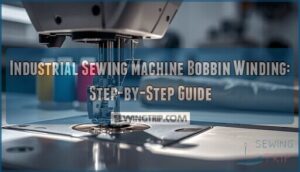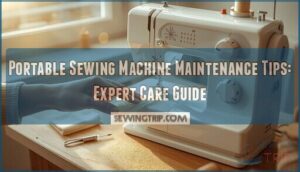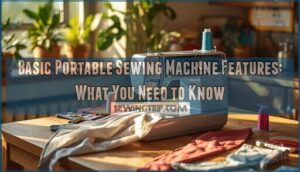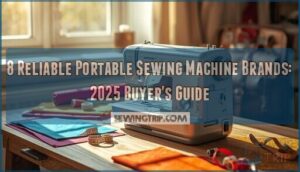This site is supported by our readers. We may earn a commission, at no cost to you, if you purchase through links.
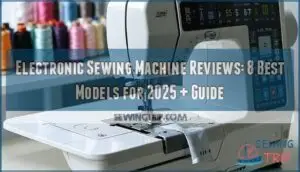 When you’re hunting for the perfect electronic sewing machine, you’ll want to cut through the marketing noise and focus on what really matters.
When you’re hunting for the perfect electronic sewing machine, you’ll want to cut through the marketing noise and focus on what really matters.
Electronic sewing machine reviews reveal that models like the Brother XM2701 and Singer Quantum Stylist shine because they balance advanced features with reliability.
You’re looking at machines that offer automatic threading, dozens of built-in stitches, and tension control that actually works.
The sweet spot sits between $150-$400, where you’ll find computerized models that won’t break the bank or your patience.
Smart shoppers know that the right machine depends on matching features to your actual projects, not just impressive spec sheets.
Table Of Contents
- Key Takeaways
- Electronic Sewing Machines
- Top 8 Electronic Machines
- 1. Brother Computerized Sewing Quilting Machine
- 2. Portable sewing machine for quilting
- 3. Singer Heavy Duty Sewing Machine
- 4. Singer Quantum Stylist Sewing Machine
- 5. Juki sewing and quilting machine
- 6. Bernette computerized sewing embroidery machine
- 7. Brother Sewing and Embroidery Machine
- 8. Brother Project Runway Sewing Machine
- Choosing Right Sewing Machine
- Sewing Machine Maintenance
- Advanced Sewing Machine Features
- Frequently Asked Questions (FAQs)
- Conclusion
Key Takeaways
- You’ll find the sweet spot for electronic sewing machines between $150-$400, where models like the Brother XM2701 and Singer Quantum Stylist deliver advanced features like automatic threading and reliable tension control without breaking your budget.
- You should prioritize machines that match your actual projects rather than impressive spec sheets – look for essential features like automatic needle threaders, drop-in bobbins, and adjustable speed controls that’ll make your sewing easier and more precise.
- You can extend your machine’s life significantly by cleaning and oiling it every 8-10 hours of use, storing it in a cool dry place, and following proper threading techniques to prevent costly repairs and maintain smooth operation.
- You’re better off choosing beginner-friendly machines with intuitive interfaces and expandable features that grow with your skills, rather than overwhelming computerized models with hundreds of stitches you’ll never use.
Electronic Sewing Machines
Electronic sewing machines combine the reliability of traditional mechanical systems with modern conveniences like automatic needle threaders, drop-in bobbins, and adjustable speed controls that make your sewing projects easier and more precise.
You’ll find these machines offer at least seven built-in stitches, including essential functions like buttonholes, blind hems, and stretch stitching.
Plus, they have helpful features like LED lighting and reverse-stitch levers that save time and reduce eye strain.
Computerized Models and Features
Today’s computerized sewing machine models transform your creative process with advanced techsavvy features that streamline every project.
You’ll discover touchscreen interface controls that make selecting from hundreds of stitches effortless, while stitch customization options let you adjust length, width, and density with precision.
Memory functions store your favorite settings, and software updates keep your machine current with new capabilities.
Built-in sensor technology automatically adjusts tension and pressure for different fabrics.
These sewing machine features in computerized models deliver professional results whether you’re tackling quilts or garments, making complex techniques accessible to sewers at every skill level.
Many models also offer automatic threading systems for easier setup.
Mechanical Machines and Benefits
Mechanical machines offer rock-solid Mechanical Durability that outlasts computerized models by years.
You’ll get superior Stitch Quality with precise Manual Control over tension and speed settings.
Repair Simplicity means fewer headaches when something breaks – no complex electronics to diagnose.
Cost Efficiency makes these mechanical sewing machines perfect for any beginner wanting reliable performance without breaking the bank on their first electronic sewing machine reviews purchase.
Serger and Overlock Machines
Three key features make serger and overlock machines game-changers for your sewing projects. These specialized tools excel at creating professional edges that regular machines simply can’t match. Different Serger Types handle various Thread Count configurations, while Overlock Stitches deliver that coveted commercial finish.
Differential Feed technology prevents fabric stretching, making these machines perfect for stretchy fabrics like jersey and spandex. You’ll master Rolled Hemming techniques that transform raw edges into delicate, finished details.
- Creates durable, flexible seams that won’t break under stress
- Trims excess fabric while stitching for clean, precise edges
- Handles knits and wovens with equal precision using differential feed
- Produces rolled hems in seconds for professional-looking garments
- Enables creative decorative edging techniques with specialty threads
Top 8 Electronic Machines
You’ll find eight electronic sewing machines that stand out for their performance, features, and value in today’s market.
These machines combine computerized precision with user-friendly designs, offering everything from basic stitching to advanced embroidery functions that’ll match your specific sewing needs.
1. Brother Computerized Sewing Quilting Machine
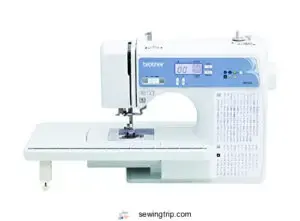
Precision meets versatility in the Brother XR9550, a computerized powerhouse that transforms your quilting dreams into reality.
This machine delivers 165 built-in stitches, including 110 utility and decorative options, plus 55 alphanumeric stitches for personalized projects.
You’ll appreciate the large LCD screen that simplifies stitch selection, while the automatic needle threader eliminates squinting and frustration.
The jam-resistant drop-in bobbin system keeps your workflow smooth, and the included wide table accommodates larger quilts with ease.
Eight specialized presser feet handle everything from buttonholes to zipper installation.
At just 10.1 pounds, it’s surprisingly portable for travel projects.
Brother backs this investment with a 25-year warranty and lifetime technical support, making it ideal for both beginners and experienced quilters.
Best For: Beginners and experienced quilters seeking a portable, feature-rich sewing machine for versatile and detailed projects.
- 165 built-in stitches, including decorative and alphanumeric options
- Lightweight and portable design with a wide table for large projects
- Automatic needle threader and jam-resistant bobbin for smooth operation
- Refurbished models may require troubleshooting
- Limited to 120 volts, restricting international use
- May not meet the needs of advanced embroidery enthusiasts
2. Portable sewing machine for quilting
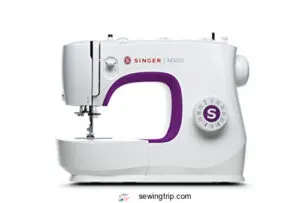
Looking for quilting freedom without being chained to your sewing room? Portable sewing machines transform your creative possibilities.
The SINGER M3500 delivers impressive 110 stitch applications in a compact design that won’t break your back during transport.
You’ll appreciate the one-step buttonhole feature and automatic needle threader – especially during marathon quilting sessions when your eyes start protesting.
With 5.7 inches of workspace and bright LED lighting, you can tackle ambitious projects anywhere.
The heavy-duty metal frame provides rock-solid stability while keeping the weight manageable for quilting retreats, classes, or simply moving between rooms at home.
Best For: Quilters seeking a lightweight, versatile, and beginner-friendly machine for on-the-go creativity and diverse stitching needs.
- Compact and lightweight design for easy portability.
- Offers 110 stitch applications, including decorative and stretch stitches.
- Features a one-step buttonhole and built-in needle threader for convenience.
- Limited workspace for larger quilting projects.
- Reports of jamming and initial difficulty with the auto thread feature.
- Incompatible voltage for use in some countries like the UK.
3. Singer Heavy Duty Sewing Machine
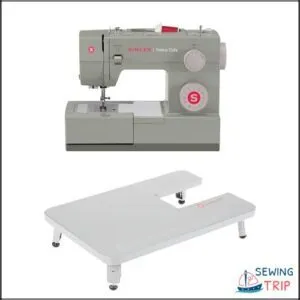
Tackling thick fabrics and heavy-duty projects requires the right tool, and SINGER’s Heavy Duty 4452 delivers exactly that.
This powerhouse features a motor that’s 60% stronger than standard machines, letting you sew at speeds up to 1,100 stitches per minute. Its heavy-duty metal frame won’t wobble or skip stitches, even when handling multiple layers of denim or canvas.
You’ll find 32 built-in stitches covering basics, decorative options, and stretch stitches.
The automatic needle threader saves time and reduces eye strain, while the stainless steel bed plate guarantees smooth fabric flow.
The included walking foot handles layered fabrics like a pro, making quilting and upholstery projects much easier to manage.
Best For: Beginner to advanced sewists looking for a durable, high-speed machine to handle heavy-duty fabrics and versatile sewing projects.
- Powerful motor with 1,100 stitches per minute for faster projects.
- 32 built-in stitches including stretch and decorative options.
- Heavy-duty metal frame ensures stability and durability.
- Lacks "needle down" feature for precision sewing.
- Cannot attach extended arm to the walking foot.
- Limited stitch variety compared to computerized models.
4. Singer Quantum Stylist Sewing Machine
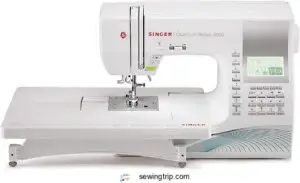
The Singer Quantum Stylist 9960 delivers professional-grade performance with its remarkable 600 built-in stitches and 1,172 stitch applications – that’s enough variety to tackle any project you can dream up.
You’ll love the automatic needle threader that eliminates eye strain, while the top drop-in bobbin system keeps thread changes simple and visible.
The machine’s mirror imaging feature opens creative doors, and 13 one-step buttonhole styles handle everything from delicate blouses to heavy coats.
Twin LED lights illuminate your workspace perfectly, and the durable metal frame guarantees stability during high-speed sewing at 850 stitches per minute.
It’s a dream machine that grows with your skills.
Best For: Sewing enthusiasts and advanced users who want a versatile, feature-packed machine for professional-grade projects.
- 600 built-in stitches with 1,172 applications for creative flexibility.
- Automatic needle threader and top drop-in bobbin for convenience.
- Durable metal frame ensures stability during high-speed sewing.
- Automatic thread cutter functionality can be problematic.
- May feel overwhelming for absolute beginners.
- Included ¼" patchwork foot may be too narrow for effective use.
5. Juki sewing and quilting machine
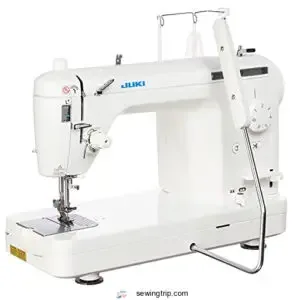
Built like a tank with aluminum die-cast construction, the Juki TL-2010Q delivers industrial-grade performance at 1500 stitches per minute.
You’ll get smooth, quiet operation that handles everything from delicate silks to thick denim without breaking a sweat.
The automatic needle threader and thread cutter save time on every project, while LED lighting illuminates your work perfectly.
What sets this machine apart is its knee-operated presser foot lifter – keeping your hands free for precise fabric control.
This straight-stitch specialist excels at quilting and heavy-duty sewing.
Sure, it only does one stitch, but it does it exceptionally well.
Perfect for sewers who value speed, precision, and reliability over fancy features.
Best For: Serious quilters and sewers who prioritize speed, precision, and industrial-grade performance for heavy-duty projects.
- Limited to straight stitch only.
- May require regular oiling for maintenance.
- Foot pedal issue reported by some users cutting thread unexpectedly.
- Industrial-grade construction with aluminum die-cast materials.
- Automatic needle threader and thread cutter for efficiency.
- Smooth, quiet operation even at 1500 stitches per minute.
6. Bernette computerized sewing embroidery machine
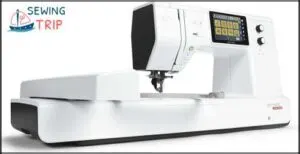
Combining precision with versatility, Bernette’s B79 delivers an impressive 500-stitch collection alongside a built-in Stitch Designer for custom creations.
The 5-inch color touchscreen simplifies navigation, letting you edit embroidery motifs with confidence.
This dual-purpose machine excels at both sewing and embroidery projects.
Its dual feed system guarantees even fabric handling, while the programmable foot control with back-kick function gives you complete control over your stitching pace.
The package includes three embroidery hoops and helpful on-board menus that guide you through complex projects.
You’ll appreciate the cast aluminum frame that provides stability and the bright LED lighting for detailed work.
Keep in mind the 40-second startup time and somewhat complex menu system.
The snap-in presser feet and specific bobbin thread requirements for embroidery might require adjustment, but the machine’s Swiss precision since 1893 makes it worthwhile for serious sewists.
Best For: Experienced sewists and embroidery enthusiasts looking for a versatile and high-quality machine.
- Combines sewing and embroidery functions with 500 stitch options.
- Includes a dual feed system and programmable foot control for precision work.
- Offers a sturdy cast aluminum frame and bright LED lighting for stability and visibility.
- Long startup time of over 40 seconds.
- Function menus can be unintuitive for some users.
- Requires specific bobbin thread for embroidery projects.
7. Brother Sewing and Embroidery Machine
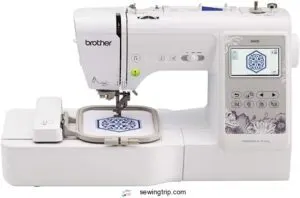
The Brother SE600 stands out as a dual-purpose powerhouse that embroidery and sewing enthusiasts can’t resist.
You’ll appreciate the 3.2" LCD color touchscreen that previews your designs before stitching begins. With 103 built-in sewing stitches and 80 embroidery designs, this machine handles everything from basic hemming to intricate decorative work.
The automatic needle threader eliminates eye strain, while the jam-resistant drop-in bobbin keeps your workflow smooth. The 4" x 4" embroidery field provides ample space for most projects, though larger designs require repositioning.
At 710 stitches per minute, it maintains impressive speed without sacrificing precision. Whether you’re a beginner exploring embroidery or an experienced sewist expanding capabilities, this versatile machine delivers professional results consistently.
Best For: Beginners and experienced sewists looking for an affordable, versatile machine that combines sewing and embroidery functions.
- Limited embroidery field size of 4" x 4" restricts larger projects.
- Requires manual repositioning for designs bigger than the embroidery area.
- Bulky design takes up considerable workspace.
- Offers 103 sewing stitches and 80 embroidery designs, making it highly versatile.
- Features a 3.2" LCD touchscreen for design previews and easy operation.
- Automatic needle threader and jam-resistant bobbin simplify sewing.
8. Brother Project Runway Sewing Machine
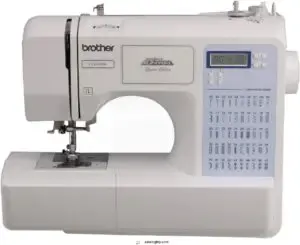
This versatile machine brings professional-level capabilities to your sewing room with 50 built-in stitches and 5 auto-size buttonholes.
You’ll breeze through projects thanks to the automatic needle threader and jam-resistant drop-in top bobbin system.
The LCD screen makes stitch selection simple, while 7 specialty feet handle everything from zippers to blind hems.
Weighing just 14.75 pounds, it’s perfect for taking to classes or moving between rooms.
The LED-lit work area helps you see every detail, especially on dark fabrics.
While there’s no carrying case included, you get a thorough accessory kit and 25-year warranty.
It’s an excellent choice for both beginners learning the ropes and experienced sewers tackling complex projects.
Best For: Beginners and experienced sewers looking for a lightweight, portable machine with versatile features.
- 50 built-in stitches with 5 auto-size buttonholes.
- Lightweight design and LED-lit work area for portability and visibility.
- Includes an accessory kit with 7 sewing feet and tools.
- Does not include a carrying case.
- Requires clear acrylic bobbins; metal bobbins are incompatible.
- Needle position settings can be complex to adjust.
Choosing Right Sewing Machine
You’ll need to match your sewing goals with the right machine features, whether you’re starting with basic stitches or planning complex projects.
Consider your budget, skill level, and the types of fabrics you’ll work with most often, since these factors determine which electronic sewing machine will serve you best, based on your budget.
Budget and Versatility Considerations
When choosing your electronic sewing machine, your initial investment doesn’t need to break the bank.
Budget-friendly options like the Brother XM2701 and Singer 7258 offer excellent long-term value under $200. Consider project variety you’ll tackle and your skill progression timeline when prioritizing features.
The Brother XM2701’s price is a key factor for many buyers.
Here’s what smart shoppers focus on:
- Stitch versatility – More built-in stitches mean greater project flexibility
- Construction quality – Metal frames last longer than plastic alternatives
- Included accessories – Extra presser feet and bobbins add immediate value
Remember, the best beginner sewing machines balance affordability with room to grow.
Ease of Use and Growth Features
Beyond budget concerns, you’ll want an easy to use sewing machine that won’t leave you frustrated on day one. Smart beginner sewing machines balance beginner friendliness with room to grow your skills over time.
Look for these ease of use and growth features in your computerized sewing machine:
- Intuitive interface with clearly marked buttons and simple navigation
- Quick-start guides that get you sewing within hours of unboxing
- Expandable features like additional presser feet you can add later
- Adjustable speed controls that accommodate your learning curve
- Built-in tutorials and stitch guides for hands-on learning
This long-term value approach means your sewing machine for beginners grows alongside your developing expertise. Many beginners find that mechanical sewing machines offer impressive durability.
Key Features for Beginners
Shopping for your first electronic sewing machine means prioritizing key features for beginners that won’t overwhelm you.
Look for automatic needle threaders and easy threading systems that eliminate squinting and frustration.
Speed control lets you start slow while learning simple stitching techniques.
Choose an easy to use sewing machine with basic presser feet included and a clear user manual.
These sewing machine for beginners essentials build confidence before tackling advanced features.
Sewing Machine Maintenance
You’ll extend your electronic sewing machine’s life substantially by cleaning and oiling it every 8-10 hours of use, which prevents thread jams and keeps stitches smooth.
Proper storage in a cool, dry place and correct threading techniques will save you from costly repairs and guarantee your machine performs at its best for years.
Regular Cleaning and Oiling
Keep your electronic sewing machine humming like a well-tuned engine with consistent care. Regular cleaning and oiling prevents costly repairs and guarantees smooth operation for years.
Essential sewing machine maintenance tasks include:
- Lint removal from the bobbin area weekly using a small brush
- Oiling frequency every 8-10 hours with machine-specific lubricant on moving parts
- Bobbin maintenance by checking for thread buildup and proper tension
Professional servicing annually keeps complex components calibrated. Quality cleaning tools and proper technique make troubleshooting common issues easier, protecting your investment.
Proper Threading and Tension Settings
Threading your electronic sewing machine correctly prevents most Threading Issues and Tension Problems.
Follow your machine’s numbered threading path exactly, then test Stitch Quality on fabric scraps.
Fabric Compatibility matters – lightweight fabrics need lighter tension while heavy materials require stronger settings.
When Troubleshooting Guide steps fail, re-thread completely.
These sewing machine tips guarantee your proper threading and tension settings work perfectly every time.
Storing and Handling Machines
In regards to storing and handling machines, location makes all the difference in your sewing machine’s lifespan.
Store yours in a cool, dry area with Temperature Control to prevent Humidity Effects on delicate parts.
Always use a Dust Cover Use strategy to shield from debris.
For Transporting Machines, invest in quality Case Recommendations with padding and secure all loose components.
These sewing machine storage solutions protect your investment while ensuring it’s ready for action.
Regular cleaning helps prevent potential tension issues.
Advanced Sewing Machine Features
You’ll find that today’s electronic sewing machines pack impressive features that make your projects easier and more precise.
These advanced tools include automatic needle threaders that save time, drop-in bobbin systems for quick thread changes, and computerized controls that let you adjust speed, stitch width, and needle position with the push of a button, utilizing computerized controls.
Automatic Needle Threaders and Drop-in Bobbin Systems
Automatic needle threaders and drop-in bobbin systems transform your electronic sewing machine experience from tedious to effortless.
These computerized sewing machine features eliminate eye strain and fumbling with thread. Drop-in systems prevent bobbin jamming while expanding bobbin capacity compared to front-loading cases.
Threader reliability varies by brand, but most maintain excellent threader lifespan with proper care. System compatibility guarantees smooth operation across different thread weights, making these sewing machine reviews consistently praise these time-saving innovations for both beginners and experts.
For those seeking convenience, explore the automatic threading options available.
Free Arm and Control Options
Why settle for cramped sewing when your electronic sewing machine’s free arm opens up endless possibilities?
Free arm uses include tackling sleeves, cuffs, and curved seams with precision that flat surfaces can’t match.
Modern computerized sewing machines deliver control panel features that streamline your workflow:
- Speed control precision lets you adjust stitching pace from crawling slow to lightning fast
- Start/stop button eliminates foot pedal dependency for hands-free operation
- Foot pedal control maintains traditional tactile feedback when you prefer it
Many models also feature automatic thread cutters for convenience.
Needle Position and Thread Tension Systems
Your electronic sewing machine’s needle adjustment and tension control work together like dance partners.
Perfect tension balance prevents puckered seams, while precise stitching depends on matching thread quality to fabric compatibility.
When troubleshooting issues, check these sewing machine features first:
| Problem | Solution |
|---|---|
| Loose stitches | Increase upper tension |
| Tight stitches | Decrease upper tension |
| Thread breaks | Check automatic needle threaders alignment |
Speed and Accuracy Considerations
Why does sewing speed matter so much? Electronic machines give you precise stitching control that transforms your projects. Adjustable speeds let you tackle delicate silk or heavy denim with confidence.
Sewing machine features that boost accuracy include:
- Motor Power – consistent performance across fabric types
- Speed Control – prevents thread bunching and skipped stitches
- SPM Impact – higher speeds increase project efficiency
- Stitch Consistency – maintains even tension throughout
- Fabric Feed – smooth material handling at any pace
Sewing precision beats rushing every time. For simpler tasks, a user might prefer a mechanical sewing machine.
Additional Features Like Feed-dog Adjustments and LED Light Facilities
Modern electronic sewing machines shine with feed-dog adjustments and LED light facilities that transform your sewing experience.
Feed-dog types vary across models, offering adjustable pressure for superior fabric control. You can drop these toothy mechanisms below the surface for free-motion quilting or embroidery work.
LED light facilities eliminate shadows around your needle area, creating perfect lighting impact for precision stitching on dark fabrics. Many users find they need to adjust their feed dogs for peak performance.
- Advanced sewing machine features: Feed-dog adjustments and LED lighting boost user experience substantially.
Frequently Asked Questions (FAQs)
Should you buy an electronic sewing machine?
You’ll love electronic sewing machines if you want consistent stitches, built-in patterns, and user-friendly features.
They’re perfect for beginners who need reliability and experienced sewers wanting advanced capabilities without breaking the bank.
How do I find the perfect electronic sewing machine?
Over 85% of sewers replace their first machine within two years due to poor initial choices.
You’ll find your perfect electronic sewing machine by matching features to your projects, testing stitch quality, and prioritizing user-friendly controls.
What is the best computerized sewing machine?
You’ll want the Brother CS7000X for its 70 stitches, excellent performance, and reasonable price.
The Singer Quantum Stylist 9960 with 600 stitches also ranks highly.
Both offer reliability and features that’ll grow with your skills.
What is an electronic sewing machine?
Electronic excellence emerges when you explore these modern marvels.
You’ll find electronic sewing machines blend computerized controls with traditional mechanics, offering programmable stitches, automatic features, and digital displays that make sewing simpler and more precise.
They offer programmable stitches, automatic features, and digital displays that make sewing simpler and more precise.
How do electronic sewing machines differ from other sewing machines?
Unlike mechanical machines that use gears and levers, you’ll find electronic models use motors and circuits for precise control.
They offer programmable stitches, automatic features, and digital displays that mechanical machines simply can’t match.
Why are electronic sewing machines so popular?
You’ll love how electronic sewing machines combine convenience with precision.
They offer automatic features like needle threading, hundreds of built-in stitches, and computerized controls that make complex projects manageable for any skill level.
Are electronic sewing machines worth it?
You’ll find electronic sewing machines absolutely worth the investment.
They offer precise stitch control, automatic threading, and versatile features that save time while delivering professional results.
For both beginners and experienced sewists, these machines provide benefits, offering professional results.
Are computerized sewing machines better?
Computerized models offer precision and convenience you’ll appreciate.
They provide consistent stitch quality, automatic settings, and advanced features like touchscreen controls.
However, they’re pricier and may need more maintenance than mechanical machines.
How to choose an electric sewing machine?
Picking the perfect electric sewing machine isn’t rocket science—just match your needs to machine features.
Consider your budget, required stitches, and skill level.
Check for automatic threading, adjustable speeds, and sturdy construction for lasting performance.
What are the disadvantages of a computerized sewing machine?
You’ll face higher repair costs, complex troubleshooting, and potential software glitches with computerized machines.
They’re more expensive upfront, require technical knowledge for advanced features, and can overwhelm beginners with too many options, leading to complex issues.
Conclusion
Perfect picks from these electronic sewing machine reviews prove that smart shopping beats splurging on fancy features you’ll never use.
You’ve got the knowledge to match your machine to your actual needs, whether you’re crafting simple hems or complex quilts.
Remember that reliable brands like Brother and Singer offer solid performance without breaking your budget.
Don’t overthink it—choose the model that fits your skill level, space, and wallet, then start creating those projects you’ve been dreaming about with actual needs in mind.

